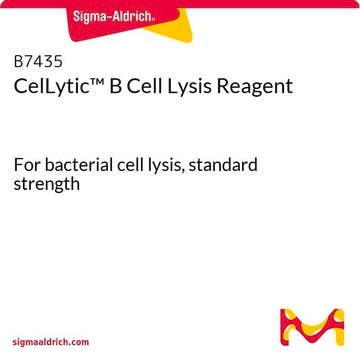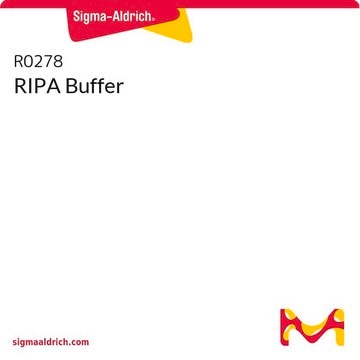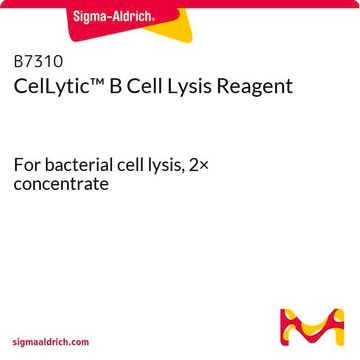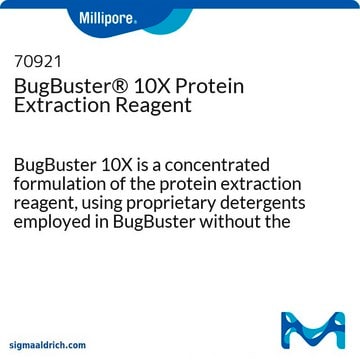C8740 does not interfere with downstream applications such as 6X HisTag affinity tag purification, or detection on a Western Blot with an anti-6X His antibody.
If the intention is to conjugate a protein to a 6X HisTag, the protein should first be purified from the lysate before conjugation. C8740 will not interfere with a conjugation protocol after the protein of interest has been isolated from the lysate.
C8740
CelLytic™ B Cell Lysis Reagent
For bacterial cell lysis, 10× concentrate
Synonyme(s) :
bacterial cell lysis reagent
Sélectionner une taille de conditionnement
131,00 €
Sélectionner une taille de conditionnement
About This Item
131,00 €
Produits recommandés
Forme
liquid
Vous recherchez des produits similaires ? Visite Guide de comparaison des produits
Application
Caractéristiques et avantages
- Higher protein extraction efficiency than traditional methods such as sonication and lysozyme
- Scalable for 1 to 25 grams of bacterial cell paste
- No interference with downstream applications such as affinity chromatography, IP, and Western blotting
- Compatible with protease inhibitors, inhibitor cocktails, chaotropes, salts, chelating agents and reducing agents
Autres remarques
Informations légales
Mention d'avertissement
Warning
Mentions de danger
Conseils de prudence
Classification des risques
Eye Irrit. 2 - Skin Irrit. 2
Code de la classe de stockage
12 - Non Combustible Liquids
Classe de danger pour l'eau (WGK)
WGK 3
Point d'éclair (°F)
Not applicable
Point d'éclair (°C)
Not applicable
Équipement de protection individuelle
Eyeshields, Gloves, type ABEK (EN14387) respirator filter
Faites votre choix parmi les versions les plus récentes :
Certificats d'analyse (COA)
Vous ne trouvez pas la bonne version ?
Si vous avez besoin d'une version particulière, vous pouvez rechercher un certificat spécifique par le numéro de lot.
Déjà en possession de ce produit ?
Retrouvez la documentation relative aux produits que vous avez récemment achetés dans la Bibliothèque de documents.
Les clients ont également consulté
-
Can this product safe to be used for downstream crosslinking stains such as a 6x HIsTag?
1 answer-
Helpful?
-
-
Can I use the CelLytic™ B cell lysate in an activity assay?
1 answer-
CelLytic B contains a zwitterionic detergent so the protein is active and can be used in protein activity assays.
Helpful?
-
-
When using the CelLytic™ B lysis reagent, do I need to make a dilution prior to measuring protein by Bradford assay?
1 answer-
When using the CelLytic™ B lysis reagent (B7435, B7310, C8740, and contained in kits CB0050 and CB0500), it is best to use a 1:10 dilution in order to reduce the risk of interference with the Bradford Reagent. A 1:20 dilution would be even better, as long as the protein level remains within the standard curve.
Helpful?
-
-
What bacterial cells can be used with CelLytic B?
1 answer-
CelLytic B Reagent by itself (no lysozyme or benzonase) was optimized for E. coli strain BL21. It also works with other common E. coli strains such as DH5?, JM109, and HB 101. The CelLytic B Reagent may be used on other similar bacterial cells. The CelLytic B Plus Kit is compatible with many more difficult to lyse Gram positive bacteria such as Bacillus and Streptococcus.
Helpful?
-
-
Can I concentrate my sample that was made using CelLytic B?
1 answer-
If concentrating a sample, be aware that concentration using filter concentrators may increase the detergent concentration significantly and cause issues in downstream applications. heoretically, ways to get around this are TCA precipitation, or diluting the extract below the CMC prior to concentration. This would be at least a 1/5 dilution, based on the following reference: Saito, S., and Tsuchiya, T., Characteristics of n-octyl beta-D-thioglucopyranoside, a new non-ionic detergent useful for membrane biochemistry. Biochem. J., 222(3), 829-832, 1984.
Helpful?
-
-
What is the difference between CelLytic B (Product Nos. B7435, B7310, C8740) and CelLytic B Plus (Product Nos. CB0050 and CB0500)?
1 answer-
CelLytic B Plus contains CelLytic B, Product No. B7435 as well as lysozyme, benzonase, and a protease inhibitor cocktail for a complete reagent for cell lysates for protein isolation.
Helpful?
-
-
Can I obtain protein from inclusion bodies with CelLytic B?
1 answer-
If the protein is found in inclusion bodies, you need to use an additional reagent, Product No. C5236, CelLytic IB to solubilize the proteins from the inclusion bodies. CelLytic B is used to isolate the inclusion bodies from the bacteria. CelLytic IB, Product No. C5236 can then be used to solubilize the proteins from the inclusion bodies.
Helpful?
-
-
What is the Department of Transportation shipping information for this product?
1 answer-
Transportation information can be found in Section 14 of the product's (M)SDS.To access the shipping information for this material, use the link on the product detail page for the product.
Helpful?
-
-
Can I use CelLytic B for eukaryotic cells?
1 answer-
CelLytic B was optimized for bacterial cells. It may lyse some mammalian cells. CelLytic B 10X is a better choice for the lysis of yeast and mammalian cells due to the increased detergent concentration.
Helpful?
-
-
Can I use CelLytic B with the maltose binding protein system (MBP System)?
1 answer-
CelLytic B cannot be used with the MBP system. We have used this in the maltose binding protein system, and know that it will NOT work in this system, since any and all detergents will destroy binding of protein to the resin.
Helpful?
-
Active Filters
Notre équipe de scientifiques dispose d'une expérience dans tous les secteurs de la recherche, notamment en sciences de la vie, science des matériaux, synthèse chimique, chromatographie, analyse et dans de nombreux autres domaines..
Contacter notre Service technique
















